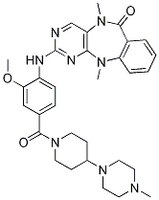438193 Sigma-AldrichLRRK2-IN-1 - CAS 1234480-84-2 - Calbiochem
LRRK2-IN-1, CAS 1234480-84-2, is a cell-permeable, ATP competitive, selective LRRK2 inhibitor (IC50 = 13, 6 & 2.45 µM for WT, G2019S mutant & drug resistant A2016T mutant LRRK2, respectively).
More>> LRRK2-IN-1, CAS 1234480-84-2, is a cell-permeable, ATP competitive, selective LRRK2 inhibitor (IC50 = 13, 6 & 2.45 µM for WT, G2019S mutant & drug resistant A2016T mutant LRRK2, respectively). Less<<Synonymes: LRRK2 Inhibitor I
Produits recommandés
Aperçu
| Replacement Information |
|---|
Tableau de caractéristiques principal
| CAS # | Empirical Formula |
|---|---|
| 1234480-84-2 | C₃₁H₃₈N₈O₃ |
Products
| Référence | Conditionnement | Qté | |
|---|---|---|---|
| 438193-5MG | Flacon en verre | 5 mg |
| References | |
|---|---|
| References | Deng, X., et al. 2011. Nat. Chem. Biol. 7, 203. |
| Product Information | |
|---|---|
| CAS number | 1234480-84-2 |
| Form | Yellow-white to pale yellow powder |
| Hill Formula | C₃₁H₃₈N₈O₃ |
| Chemical formula | C₃₁H₃₈N₈O₃ |
| Structure formula Image | |
| Quality Level | MQ100 |
| Biological Information | |
|---|---|
| Purity | ≥95% by HPLC |
| Physicochemical Information |
|---|
| Dimensions |
|---|
| Materials Information |
|---|
| Toxicological Information |
|---|
| Safety Information according to GHS |
|---|
| Safety Information |
|---|
| Product Usage Statements |
|---|
| Packaging Information | |
|---|---|
| Packaged under inert gas | Packaged under inert gas |
| Transport Information |
|---|
| Supplemental Information |
|---|
| Specifications |
|---|
| Global Trade Item Number | |
|---|---|
| Référence | GTIN |
| 438193-5MG | 07790788060954 |
Documentation
LRRK2-IN-1 - CAS 1234480-84-2 - Calbiochem FDS
| Titre |
|---|
LRRK2-IN-1 - CAS 1234480-84-2 - Calbiochem Certificats d'analyse
| Titre | Numéro de lot |
|---|---|
| 438193 |
Références bibliographiques
| Aperçu de la référence bibliographique |
|---|
| Deng, X., et al. 2011. Nat. Chem. Biol. 7, 203. |







